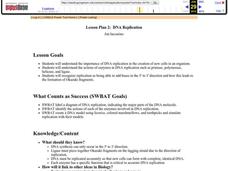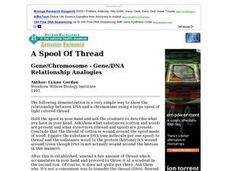Curated OER
Dragon Genetics Lab-Principles of Mendelian Genetics
Students study genetic traits using popsicle sticks as chromosomes. For this biology lesson, students explain how traits are inherited from parents. They differentiate dominant and recessive genes.
Curated OER
Dragon Genetics-Independent Assortment and Genetic Linkage
Students build chromosome models using popsicle sticks. In this biology lesson, students simulate the Law of Independent Assortment. They use Punnett squares to predict the resulting genotype and phenotype.
Curated OER
Teacher Preparation Notes on Genetics
Students explore genetics through various hands-on activities. In this biology lesson, students predict the probability of offspring genotypes and phenotypes using the Punnett Square. They explain the causes of genetic abnormalities.
Curated OER
Gametogenesis and Fertilization
Students explore how this module focuses on part of the cycle of alternation of generations: meiosis to produce haploid spores and fertilization to produce a diploid zygote which grows into the adult plant.
Curated OER
Human Genome Debate
Learners study the Human Genome Project and participate in a debate about the project. In this genome lesson, students review the terms related to the genome project, take a poll about the ethical issues of the project, and watch a video...
Curated OER
The Spanish Omelet
Young scholars use analogies to show the relationships among cell, nucleus, genes, chromosome, ribosome, replication, mitosis, transcription, translation, DNA, RNA, amino acids and proteins, genotype, phenotype, and genetics vs....
Curated OER
Basic Introduction to Foundation of Life: Genes, Genetics and Genetic Diseases
Learners are introduced to genetics along with genetic diseases and heredity. In groups, they complete a Punnett Square to determine the dominant and recessive genes. After viewing diagrams, they identify the characteristics of DNA and...
Curated OER
Cell Review Test
Seventh graders engage in a lesson that is concerned with the basic structure and function of the cell. They systematically cover the different parts of the cell that includes active transport, organelles, mitosis, and meiosis. The...
Curated OER
Drosophila Melanogaster
Students cross wild type flies and mutants, both purchased from a biological supply house (Carolina Biological Supply or Wards, for example) in groups from activity one.
Curated OER
AN EMBRYOLOGY PLACE MAT
High schoolers create a place mat to attain the following objectives: determine the important ideas, concepts, and definitions relating to a list of embryological terms. Match the terms with their definitions and create short quizzes for...
Curated OER
Human Development: The First Trimester & Developmental Malformations
Students, analyze and discuss cleft lip, cleft palate, anencephaly, spina bifida and septal defects in the heart--well-known malformations that can occur in the first trimester of prenatal devalopment. They play the review game, Fetal...
Curated OER
What Are the Most Recent Developments in Animal and Human Cloning?
Students research the developments of animal and human cloning. They report their findings to the class. They write journal entries as well.
Curated OER
DNA Replication
Students create a model of DNA and simulate replication with their models in an activity that uses licorice, colored marshmallows, and toothpicks. Students also label a diagram of replication and indicate major parts of the DNA molecule.
Curated OER
Wait, They Can do it by Themselves?
High schoolers recognize the concepts of evolution and natural selection as well as cladistics and phylogenetics. They observe the process of regeneration in a sea anemone to simulate asexual reproduction.
Curated OER
Homologous Shoes
Students examine the concept of homology by observing their shoes and those of their classmates. They summarize the observations of everyone's shoes relating it to chromosomes in cells. They share their observations with the class.
Curated OER
Spermatogenesis versus Oogenesis
Learners compare and contrast the processes of spermatogenesis and oogenesis. This lesson uses the KWL+ strategy to promote reading. The + used here is the Venn diagram.
Curated OER
A Spool Of Thread
Students describe a spool of light colored thread that the teacher holds in his/her hands. They are asked what substances (cotton and wood) are present and what structures (thread and spool) are present. The teacher conclude that the...
Curated OER
Heredity (Mendelian Genetics)
Students observe and record observations of whether a person is a taster or nontaster. They test selected individuals from their families and peer groups and chart all findings to determine which trait (e.g. taster or non-taster) is...

















